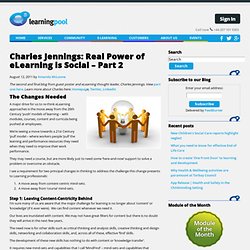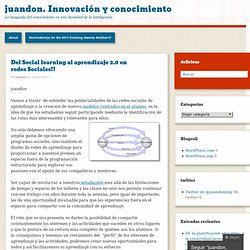

Real Power of eLearning is Social–Part 2. The second and final blog from guest poster and eLearning thought leader, Charles Jennings.

View part one here. Learn more about Charles here: Homepage, Twitter, LinkedIn The Changes Needed A major drive for us to re-think eLearning approaches is the move away from the 20th Century ‘push’ models of learning – with modules, courses, content and curricula being pushed at employees. We’re seeing a move towards a 21st Century ‘pull’ model – where workers people ‘pull’ the learning and performance resources they need when they need to improve their work performance.
They may need a course, but are more likely just to need some ‘here-and-now’ support to solve a problem or overcome an obstacle. I see a requirement for two principal changes in thinking to address the challenge this change presents to Learning professionals: A move away from content-centric mind-sets.A move away from ‘course’ mind-sets. Step 1: Leaving Content-Centricity Behind Our lives are inundated with content. Content to Context. Charles Jennings: The Real Power of eLearning is Social – Part 1. The first of a two part blog from guest poster and eLearning thought leader, Charles Jennings.

Learn more about Charles here: Homepage, Twitter, LinkedIn Some Background eLearning has been with us in one form or another for at least 50 years, maybe longer. Probably the first player on the enterprise eLearning block was the University of Illinois’ PLATO learning management system, built in 1960 to deliver training through user terminals (which, even then, had touch-screens). Some would argue that quite a few of today’s LMS offerings have not advanced a great deal from PLATO. My own exposure to eLearning started in 1964 when I recall learning speed reading via an electronic system at my secondary school in Australia. However, despite the obvious limitations, technology was making its way into learning through a number of routes even back then.
My first involvement in working with and learning technology that we’d recognise today was when tutoring at the University of Sydney in the early 1970s. Four Phases of Learning. Del Social learning al aprendizaje 2.0 en Redes Sociales. Juandon Vamos a tratar de entender las potencialidades de las redes sociales de aprendizaje o la creación de nuevos modelos centrados en el alumno, es la idea de que los estudiantes seguir participando mediante la identificación de las rutas más interesantes y relevantes para ellos.

No sólo debemos ofreciendo una amplia gama de opciones de programas sociales, sino también el diseño de redes de aprendizaje para proporcionar a nuestros jóvenes un espacio fuera de la programación estructurada para explorar sus pasiones con el apoyo de sus compañeros y mentores. Ser capaz de involucrar a nuestros estudiantes más allá de las limitaciones de tiempo y espacio de los talleres y las clases no sólo nos permite continuar con ese trabajo con ellos durante toda la semana, pero igual de importante, les da una oportunidad invaluable para que las experiencias fuera en el espacio para compartir con la comunidad de aprendizaje. Me gusta: Me gusta Cargando... El Community Manager Educativo: retos y posibilidades - Capital Intelectual.